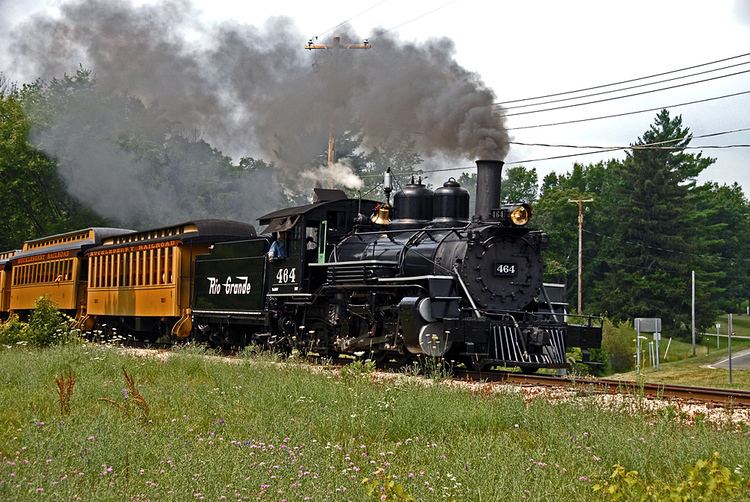Power type Steam Configuration 2-8-2 Mikado | Build date 1903 Gauge 3 ft (914 mm) | |
 | ||
Builder Baldwin Locomotive Works UIC class 1′D1′ n4v, later 1′D1′ h2 | ||
The D&RGW K-27 class are 3 foot narrow gauge, Mikado type, 2-8-2 steam railway locomotives built for the Denver and Rio Grande Railroad by the Baldwin Locomotive Works in 1903. They eventually became known by the nickname "Mudhens," and are the smallest of the four K classes of Rio Grande narrow gauge engines. Only two of the original 15 "Mudhens" survives to this day.
Contents
Origins
Fifteen locomotives were built, originally class 125, reclassified K-27 in 1924 when the Denver and Rio Grande became the Denver and Rio Grande Western Railroad. The K-27s were built as Vauclain compounds, with two cylinders on each side, expanding the steam once in the smaller cylinder and then a second time in the larger one. The extra maintenance costs of the two cylinders were greater than the fuel saving, so they were converted to simple expansion in 1907–1909. They were Rio Grande's last purchase of compound locomotives. They were built with their main structural frames outside the driving wheels, with the counterweights and rods attached outside the frames.
They had one peculiarity which arose from their outside frames and counterweights. In places where the D&RG's standard gauge system met the narrow gauge system, the railroad operated dual gauge trackage, with three rails, so that standard gauge equipment ran on the outer two rails and three foot gauge equipment ran on one of the outer rails and a third rail, inside the other two. Since the narrow gauge equipment was much lighter than the standard gauge, the inner rail was generally lighter and, therefore, not as tall as the standard gauge rails. In the case of the D&RGW, the difference was ⅞ inch (22 mm). Because the counterweights were outside the frames, they ended up directly over the standard gauge rail, with a clearance of only about ⅝ inch (16 mm). When the shop crews trued up the drivers periodically, they had to be very careful not to go too far.
They pulled freight, passenger and mixed trains on the D&RGW in and over the Colorado Rocky Mountains, traversing the entire length of the railroad. Many of them also spent time on the Rio Grande's subsidiary, the Rio Grande Southern.
Preservation
Two K-27s survive today. D&RGW #463 was sold to cowboy actor and singer Gene Autry in May 1955. Autry never used the Mudhen and donated it to the City of Antonito, Colorado. It was restored by and entered into service on the Cumbres and Toltec Scenic Railroad in 1994. It was taken out of service with a broken side rod in 2002. In 2009, it was moved to the railroad's shop at Chama, New Mexico where a major rebuild was performed. The engine made its inaugural run after the rebuild on the C&TS on May 20, 2013. 463 was added to the National Register of Historic Places in 1975 as Engine No. 463.
The other K-27 in existence is D&RGW #464. It sat outside in Durango, Colorado during the 1960s and was sold to Knott's Berry Farm in 1973. It saw little or no use there, in part because of its condition and in part because of the counterweight clearance problem described above. The Huckleberry Railroad in Flint, Michigan, acquired the locomotive in 1981, did an eight-year restoration on it, and put it into active service.
Details
The K-27s went through a variety of modifications during their 36 to 107+ years of service. They ended up in three distinct groups, with many different details such as the location of the air tanks, whether or not they had a doghouse on the tender for the head brakeman, and so forth. The most important of these details are:
